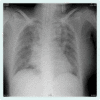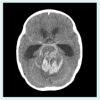Two cases of severe pneumonia after the 2011 Great East Japan Earthquake
- PMID: 23908944
- PMCID: PMC3729095
- DOI: 10.5365/WPSAR.2012.3.2.002
Two cases of severe pneumonia after the 2011 Great East Japan Earthquake
Abstract
In 2011, during the Great East Japan Earthquake and tsunami, 90% of victims died from drowning. We report on two tsunami survivors with severe pneumonia potentially caused by Legionella pneumophila. Both victims aspirated a large quantity of contaminated water; sand, mud and a variety of microbes were thought to have entered into their lower respiratory tracts. One patient had a mycotic intracranial aneurysm; the other patient had co-infections with several organisms, including Scedosporium species. Although scedosporiosis is a relatively rare infectious disease, symptoms are progressive and prognosis is poor. These pathogens are not specific for tsunami lung, but are reported causative agents for pneumonia after near-drowning.
Figures



Similar articles
-
Scedosporium aurantiacum brain abscess after near-drowning in a survivor of a tsunami in Japan.Respir Investig. 2013 Dec;51(4):207-11. doi: 10.1016/j.resinv.2013.07.001. Epub 2013 Aug 20. Respir Investig. 2013. PMID: 24238227 Review.
-
Atypical fungal vertebral osteomyelitis in a tsunami survivor of the Great East Japan Earthquake.Spine (Phila Pa 1976). 2014 May 20;39(12):E739-42. doi: 10.1097/BRS.0000000000000317. Spine (Phila Pa 1976). 2014. PMID: 24718064 Review.
-
Escherichia coli pneumonia in combination with fungal sinusitis and meningitis in a tsunami survivor after the Great East Japan Earthquake.Tohoku J Exp Med. 2012 Jul;227(3):179-84. doi: 10.1620/tjem.227.179. Tohoku J Exp Med. 2012. PMID: 22729220
-
Disseminated aspergillosis associated with tsunami lung.Respir Care. 2012 Oct;57(10):1674-8. doi: 10.4187/respcare.01701. Epub 2012 Mar 12. Respir Care. 2012. PMID: 22417634
-
Tsunami lung.J Anesth. 2012 Apr;26(2):246-9. doi: 10.1007/s00540-011-1273-6. Epub 2011 Nov 6. J Anesth. 2012. PMID: 22057370
Cited by
-
Systemic Scedosporium apiospermum Infection Affecting Multiple Sites After Near-Drowning: A Case Report.Infect Drug Resist. 2024 Dec 20;17:5739-5744. doi: 10.2147/IDR.S483524. eCollection 2024. Infect Drug Resist. 2024. PMID: 39720616 Free PMC article.
-
Respiratory Infections Following Earthquake-Induced Tsunamis: Transmission Risk Factors and Lessons Learned for Disaster Risk Management.Int J Environ Res Public Health. 2021 May 6;18(9):4952. doi: 10.3390/ijerph18094952. Int J Environ Res Public Health. 2021. PMID: 34066563 Free PMC article. Review.
-
Scedosporium Apiospermum Infection after Near-drowning.Chin Med J (Engl). 2015 Aug 5;128(15):2119-23. doi: 10.4103/0366-6999.161401. Chin Med J (Engl). 2015. PMID: 26228230 Free PMC article. No abstract available.
-
Legionella Pneumonia Following the Heavy Rain Event of July 2018 in Japan.Intern Med. 2019 Oct 1;58(19):2831-2834. doi: 10.2169/internalmedicine.2825-19. Epub 2019 Jun 27. Intern Med. 2019. PMID: 31243196 Free PMC article.
-
Characteristics of pneumonia deaths after an earthquake and tsunami: an ecological study of 5.7 million participants in 131 municipalities, Japan.BMJ Open. 2016 Feb 23;6(2):e009190. doi: 10.1136/bmjopen-2015-009190. BMJ Open. 2016. PMID: 26908515 Free PMC article.
References
-
- Jeremijenko A, McLaws ML, Kosasih H. A tsunami related tetanus epidemic in Aceh, Indonesia. Asia-Pacific Journal of Public Health. 2007;19(Spec No):40–4. - PubMed
-
- Allworth AM. Tsunami lung: a necrotising pneumonia in survivors of the Asian tsunami. The Medical Journal of Australia. 2005;182:364. - PubMed
LinkOut - more resources
Full Text Sources
